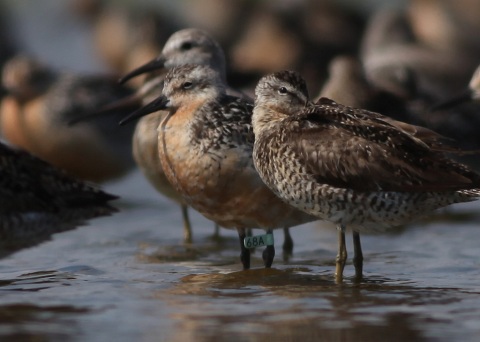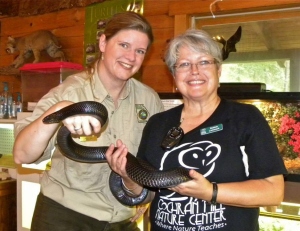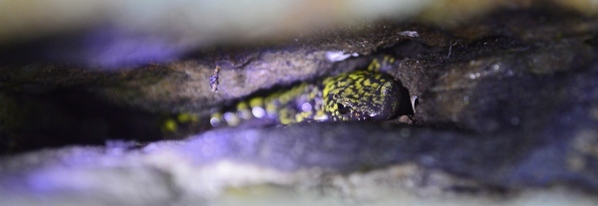 Georgia researchers monitor migration with eye on big picture
Scientists who study shorebirds know the devil is not always in the details.
Sometimes, it’s in getting the details.
The Georgia Department of Natural Resources is teaming this year with an eastern U.S.-wide project aimed at getting details on assessing populations and trends for five shorebird species – red knot, ruddy turnstone, black-bellied plover, sanderling and purple sandpiper.
Each nests in the Arctic and winters thousands of miles to the south. Evidence indicates that these and many other shorebird species are declining, said wildlife biologist Tim Keyes of DNR’s Nongame Conservation Section. “But there’s a lot of uncertainty with the data.”
Estimating entire populations from site surveys is suspect because long-distance migrants are so mobile. They’re here today and gone tomorrow – or the next hour. Even multiple site surveys can be unreliable. Except for banded birds, researchers can’t tell between new birds and ones counted before.
To counter these shortcomings, the experimental monitoring led by Jonathan Bart of the U.S. Geological Survey and fellow shorebird researcher Larry Niles, former chief of New Jersey’s nongame program, is banking on a plan that includes consistently sampling the species across their U.S. range and using geolocators.
Attached by leg band to more than 100 birds on the tundra this summer, the tiny devices record day length and sunrise and sunset times. The information retrieved from locator-packing birds trapped again next summer will help scientists determine stopover sites and durations – how long a shorebird spends in a specific coastal area. The hope is that combining stopover duration data with site counts will provide more accurate population estimates and insights into population-scale trends for the five species.
|
Q&A: Why is Georgia focusing on red knot, ruddy turnstone (right), black-bellied plover and sanderling? These four frequent our coast on migration between the Arctic and, primarily, South America (some winter in Georgia). Purple sandpipers usually range in the U.S. only as far south as North Carolina – the northernmost winter range of any shorebird. But some are seen on Tybee Island each winter.
|
|
 |
Surveys along the eastern U.S. began this year. Following protocol in what is currently a two-year project, Keyes coordinated with other agencies, organizations and volunteers in surveying about 20 sites three times in spring. They’re surveying 22 sites, from Tybee to Cumberland Island, for the fall migration.
Along with volunteers – such as Pat and Doris Leary pictured in this enews issue's masthead – partners include the U.S. Fish and Wildlife Service, St. Catherines Island, Little St. Simons Island and Cumberland Island National Seashore.
- Q&A: How do you count shorebirds? Large flocks are the challenge. If a flock is primarily one species, researchers count a “block” of 10, 50 or more birds, and then count blocks. If there are multiple species, usually the proportion of each species is estimated by block, blocks are counted and species totals extrapolated. Training, software and photos help researchers prep, and check estimates.
Keyes said the effort has expanded DNR’s shorebird monitoring, and even helped track other species – such as American oystercatchers found nesting this year on a St. Andrews Sound shell rake.
But he’s looking forward to findings from the larger survey: details that may prove critical in restoring and maintaining populations of these and other shorebirds.
Out my backdoor
 .
By Terry W. Johnson
The frightening population declines of neotropical migratory birds are well documented.
Neotropical migrants are the birds that nest throughout North America and winter in Latin America. This colorful kaleidoscope of birds includes orioles, warblers, vireos, thrushes, tanagers and other songsters.
Biologists once thought that habitat losses on winter and breeding grounds were the most serious threat faced by many of these birds. However, research conducted during the past two-and-a-half decades suggests that a dramatic loss in suitable stopover areas used by the birds on their spring and fall migrations is also playing a significant role in their alarming population losses.
Here’s where you come in.
Believe it or not, your yard can help conserve these migratory songbirds by providing a high-quality stopover site – a place where birds can rest and refuel before continuing their long journey.
Read Terry’s full column to learn more, including the critical role berries and fruits fill for migrating birds and which plants can help make your yard an avian pit stop.
Terry W. Johnson is a former Nongame program manager with the Wildlife Resources Division and executive director of TERN, the Nongame Conservation Section’s friends group. Check out his column archives.
Noteworthy
Longleaf pine restoration, including work in Georgia, drew a much-needed $3.1 million in grants this week. At Oxbow Meadows Environmental Learning Center in Columbus, the National Fish and Wildlife Foundation announced 15 grants to help restore or enhance 153,500 acres of longleaf pine habitat in seven Southeastern states.
Recipients of the Longleaf Stewardship Fund grants include the Chattahoochee Fall Line Conservation Partnership, which is working to conserve longleaf on more than 10,000 acres in the Fort Benning area, and Georgia DNR, in part to plant longleaf and improve habitat for gopher tortoises and other high-priority species on 550 acres at Flat Tub Wildlife Management Area near Douglas. Projects list.
Now in its second year, The Longleaf Stewardship Fund is a public-private partnership that includes the U.S. Department of Defense, Forest Service, Natural Resources Conservation Service, Fish and Wildlife Service and Southern Company.
The Satilla River Native Fishes Restoration crew has removed 1,963 flathead catfish totaling 2,092 pounds from the southeast Georgia river since May. That makes more than 34 tons of the invasive fish – 28,054 flatheads – the DNR Wildlife Resources Division effort has hauled from the Satilla since 2007.
 What frog is that? Jennifer Willis of Barnesville photographed this odd-looking amphibian (left) on a green pepper in her garden Aug. 19. Although it’s a barking treefrog – common across most of the state – Dr. John Maerz of UGA’s Warnell School of Forestry and Natural Resources said the uncommon coloring is from a skin mutation. Maerz writes that amphibian skin has three cell types, called chromatophores, that make color. Xanthophores produce yellows and oranges. Below them, iridophores reflect blue. In between are melanophores, which make black. Light hitting a frog’s skin reflects blue light. But it passes through yellow xanthophores, producing green. This frog is missing xanthophores on its back; hence, the bright blue patches. The big black patch is unique: Black areas would usually be small, showing up as dots, according to Maerz.
Searching for Chapman’s fringed orchid, Nongame Conservation Section botanists helped Atlanta Botanical Garden find five new populations of the special-concern orchid, more than double the number of known populations in Georgia. The three-county survey also turned up new sites for state-threatened parrot pitcherplant and state-rare purple honeycomb head.
“Life is short but snakes are long,” a blog by Utah State graduate student Andrew Durso, makes the argument that states should have state snakes. None do, Durso writes, but he has recommendations for all 50. See his choice for Georgia.
A letter urging Congress and the U.S. Senate to fund fish and wildlife programs targeted for elimination in the fiscal year starting Oct. 1 has drawn support from nearly 800 organizations nationwide, according to Teaming With Wildlife. The ongoing push follows a House subcommittee proposal to “zero out” funds for five programs, including the State Wildlife Grants critical to Georgia and other states in conserving nongame wildlife.
Rangers 1st Class David Brady and John Evans were patrolling off Cumberland Island Aug. 15 when they spotted a small shrimp trawler fishing near the beach. The rangers boarded the boat, inspected gear and licenses, and – finding several turtle excluder device violations – cited the captain for commercial fishing with illegal gear. Sign up for weekly ranger e-reports.
|
 You’ve taken the Georgia Wild survey. Now DNR’s Wildlife Resources Division needs your opinions to help guide the division’s strategic planning for the next five years. Make a difference by completing this 10- to 15-minute survey.
In the next Georgia Wild, we'll tell you who won the eagle T-shirts in the newsletter survey!
Hydraulic fracturing fluids spilling from natural gas wells killed federally threatened blackside dace (left) and other aquatic species in a Kentucky creek in 2007, according to a recently published study by the U.S. Geological Survey and the Fish and Wildlife Service. Acorn Fork, a small Appalachian stream, is one of Kentucky's Outstanding State Resource Waters. Report.
Upcoming:
Exotic Plant BioBlitz Sept. 14 at Fort Pulaski National Monument in Savannah.
The Big Weekend: Bird ’n Butterfly-a-thon Sept. 21-22 at Price Park in Kennesaw (held by Friends of Price Park).
17th Annual Outdoor Learning Symposium held by the Environmental Education Alliance of Georgia Oct. 4-5 at Oatland Island Wildlife Center near Savannah.
|
 |
|
Nongame Environmental Outreach Coordinator Linda May and Cochran Mill Nature Center Director Bobbie Laminack share an eastern indigo snake during Snake Day Aug. 24 at the Palmetto center. More photos.
|
Headlines
"(UGA) lab plays key role in identifying dolphin virus, urges people not to touch stranded animals," phys.org
"Die-off of bottlenose dolphins, linked to virus, is worst in 25 years," The Washington Post
"Take a walk to see fall bird migration," The Atlanta Constitution (Charles Seabrook column)
"Frogs that hear with their mouth," European Synchrotron Radiation Facility
"An emotional salute to ‘good folks,’ Don and Lucile Carter," The (Gainesville) Times
"Watching for whimbrels," WVTF (public radio)
(+video) "Snakehead fish: Can invasive species be eaten out of existence?" BBC
"Streams can act as high-speed corridors for plants," Conservation Corridor (citing Journal of Applied Ecology article)
"How (and why) to build a dune," National Geographic
"Camping: one city family's first time (and why you should try it, too)," Nature Rocks (The Nature Conservancy blog)
"Warming Antarctic seas likely to impact on krill habitats," British Antarctic Survey
"Conservationists bristle at new Jekyll development plans," Florida Times-Union
"Sierra creek to be treated this week to restore rare trout," USA Today
"Woodland salamanders indicators of forest ecosystem recovery," U.S. Forest Service
"Wise old birds help whooping cranes stay on course," University of Maryland
"Snapping turtles finding refuge in urban areas while habitats are being polluted or developed," University of Missouri
"MDC confirms mountain lion sighting in Pulaski County," Missouri Department of Conservation
"First estimate of total viruses in mammals," Columbia University
"9 endangered venomous vipers born at St. Louis Zoo," Fox News
Parting shot
 Add this green salamander to the growing list of those documented in Georgia's Ridge and Valley Province. Nate Thomas of DNR's Nongame Conservation Section recently found and photographed this rare salamander sandwiched in a rock crevice on private land near Summerville. For more on green "sallies" in the Ridge and Valley, see the previous Georgia Wild.
Credits
** Masthead: Georgia volunteers Pat and Doris Leary help survey shorebirds. Brad Winn/Manomet Center for Conservation Sciences
** Red knots, including one with a leg band. Brad Winn/Manomet Center for Conservation Sciences
** Ruddy turnstone. Tim Keyes/Ga. DNR
** Gray catbird eating berries of American beautyberry. Terry W. Johnson
** Odd-colored barking treefrog. Jennifer Willis
** Blackside dace. Conservation Fisheries Inc.
** Linda May and Bobbie Laminack with eastern indigo snake. Cochran Mill Nature Center
** Green salamander. Nate Thomas/Ga. DNR
 Give wildlife a chance!
The Nongame Conservation Section of Georgia DNR receives no state funds to conserve nongame wildlife, native plants and natural habitats. Instead, we depend on contributions, grants and fundraisers, such as the eagle and hummingbird license plates.
How can you help?
|
|